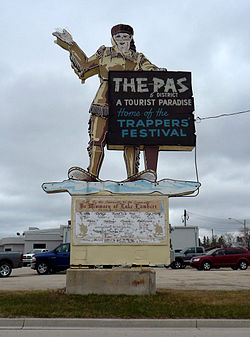The Pas | |
|---|---|
| Town of The Pas | |
 Welcome sign | |
| Motto: Adventure Territory | |
| Coordinates: 53°49′30″N 101°15′12″W / 53.82500°N 101.25333°W | |
| Country | Canada |
| Province | Manitoba |
| Region | Northern Region |
| Census division | 21 |
| Incorporated (town) | 1912 |
| Government | |
| • Mayor | Andre Murphy |
| • MLA | Amanda Lathlin |
| Area | |
| • Land | 47.83 km2 (18.47 sq mi) |
| • Urban | 14.15 km2 (5.46 sq mi) |
| Elevation | 271 m (889 ft) |
| Population | |
• Town | 5,513 |
| • Density | 115.3/km2 (299/sq mi) |
| • Urban | 5,689 |
| • Urban density | 402.1/km2 (1,041/sq mi) |
| Time zone | UTC−06:00 (CST) |
| • Summer (DST) | UTC−05:00 (CDT) |
| Forward sortation area | |
The Pas (/pɑː/ PAH) is a town in Manitoba, Canada, at the confluence of the Pasquia River and the Saskatchewan River and surrounded by the unorganized Northern Region of the province. It is approximately 520 kilometres (320 mi) northwest of the provincial capital, Winnipeg, and 35 kilometres (22 mi) from the border of Saskatchewan. It is sometimes still called Paskoyac by locals after the first trading post, called Fort Paskoya, constructed in the 1740s by French and Canadian traders. The Pasquia River begins in the Pasquia Hills in east central Saskatchewan. The French in 1795 knew the river as Basquiau.
Known as "The Gateway to the North", The Pas is a multi-industry northern Manitoba town serving the surrounding region. The main components of the region's economy are agriculture, forestry, commercial fishing, tourism, transportation, and services (especially health and education). The main employer is a paper mill operated by Canadian Kraft Paper Industries Ltd. The Pas contains one of the two main campuses of the University College of the North.
The Pas is bordered by the Rural Municipality of Kelsey, as well as part of the Opaskwayak Cree Nation.
- ^ a b "Population and dwelling counts, for Canada, provinces and territories, and census subdivisions (municipalities), 2011 and 2006 censuses (Manitoba)". Statistics Canada. January 7, 2016. Retrieved February 28, 2016.
- ^ a b "Population and dwelling counts, for Canada, provinces and territories, and population centres, 2011 and 2006 censuses (Manitoba)". Statistics Canada. January 7, 2016. Retrieved February 28, 2016.


